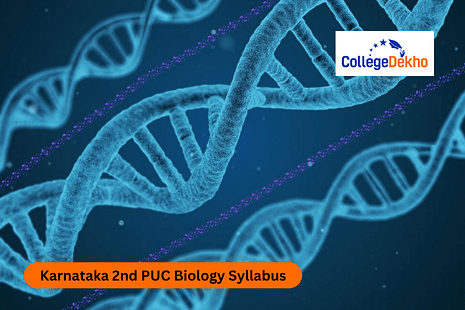

Never Miss an Exam Update
Karnataka 2nd PUC Biology Syllabus 2025-26 can be checked here. The complete 2nd PUC Biology syllabus 2025-26 is shared here for students to prepare for board exams. The syllabus includes 13 chapters, which are further divided into different subtopics. While preparing for the exam, ensure you cover each of the topics in detail. Based on the syllabus, you will have to face a theory exam of 70 marks and a practical exam of 30 marks. From different chapters, you will have to answer objective-type questions, very short answer-type questions, short answer-type questions, and long answer-type questions.
After completing the 2nd PUC Biology syllabus, you should focus on practising the Karnataka 2nd PUC Biology Model Paper s for effective revision. This will enhance your preparation level. Check out more information about the Karnataka 2nd PUC Biology Syllabus 2025-26 here.
Karnataka 2nd PUC Latest Updates 2025-26
- December 8, 2025 : The Department of Pre-University Education (DPUE) released the final Karnataka 2nd PUC Time Table 2026 on the official website - kseab.karnataka.gov.in/. The 2nd PUC board will conduct the Karnataka 2nd PUC exam 2026 from February 28 to March 17, 2026.
Karnataka 2nd PUC Biology Syllabus 2025-26
The 2nd PUC Biology chapters are described below. Go through them in detail to know the complete syllabus.
Sexual reproduction in flowering plantsFlower structure; development of male and female gametophytes; pollination – types, agencies and examples; outbreeding devices; pollen-pistil interaction; double fertilization; post fertilization events – development of endosperm and embryo, development of seed and formation of fruit; special modes – apomixis, parthenocarpy, polyembryony; Significance of seed dispersal and fruit formation.
Human reproductionMale and female reproductive systems; microscopic anatomy of testis and ovary; gametogenesis – spermatogenesis and oogenesis; menstrual cycle; fertilisation, embryo development upto blastocyst formation, implantation; pregnancy and placenta formation (elementary idea); parturition (elementary idea); lactation (elementaryidea).
Principles of inheritance and variation
Heredity and variation: Mendelian inheritance; deviations from Mendelism – incomplete dominance, co-dominance, multiple alleles and inheritance of blood groups, pleiotropy; elementary idea of polygenic inheritance; chromosomal theory of inheritance; chromosomes and genes; sex determination – in humans, fruit fly, birds, honey bee and grasshopper; linkage and crossing over; mutation; sex linked
inheritance: Mendelian disorders in humans; chromosomal disorders in humans.
Search for genetic material and DNA as genetic material; structure of DNA and RNA; DNA packaging; DNA replication; central dogma; transcription, genetic code, translation; gene expression and regulation
– lac operon; human genome project; DNA fingerprinting.
Origin of life; biological evolution and evidences for biological evolution (palaeontology, comparative anatomy, embryology and molecular evidences); Darwin’s contribution, modern synthetic theory of evolution; mechanism of evolution – variation (mutation and recombination) and natural selection with
examples, types of natural selection; gene flow and genetic drift; Hardy – Weinberg’s principle; adaptive radiation; human evolution.
Pathogens; parasites causing human diseases (common cold, dengue, chikungunya, typhoid, pneumonia, amoebiasis, malaria, filariasis, ascariasis, ring worm) and their control; Basic concepts of immunology – vaccines; cancer, HIV and AIDS; Adolescence – drug and alcohol abuse.
Microbes in human welfareIn household food processing, industrial production, sewage treatment, energy generation and microbes as biocontrol agents and biofertilisers. Antibiotics.
Biotechnology – Principles and processesGenetic Engineering (recombinant DNA technology).
Biotechnology and its applicationsApplications of biotechnology in health and agriculture: human insulin and vaccine production, stem cell technology, gene therapy; genetically modified organisms – Bt crops; transgenic animals; biosafety issues, biopiracy and biopatents.
Biodiversity and its conservationConcept of biodiversity; patterns of biodiversity; the importance of biodiversity; loss of biodiversity; biodiversity conservation; hotspots, endangered organisms, extinction, Red Data Book, biosphere reserves, national parks, sanctuaries, and Ramsar sites.
Also Read: Karnataka 2nd PUC Biology Previous Year Question Paper
Karnataka 2nd PUC Biology Marking Scheme 2025-26
Students can refer to the latest Marking Scheme fro 2nd puc biology chapters 2026 from the table given below:
Chapter | No. of Periods | Marks |
|---|---|---|
1. Sexual reproduction in flowering plants | 12 | 11 |
2. Human reproduction | 11 | 10 |
3. Reproductive health | 7 | 6 |
4. Principles of Inheritance | 15 | 13 |
5. Molecular basis of Inheritance | 15 | 13 |
6. Evolution | 8 | 7 |
7. Human health and disease | 13 | 11 |
8. Microbes in Human welfare | 8 | 7 |
9. Biotechnology: Principles and Processes | 8 | 7 |
10. Biotechnology and its applications | 7 | 6 |
11. Organism and population | 6 | 6 |
12. Ecosystem | 5 | 4 |
13. Biodiversity and Conservation | 5 | 4 |
Total | 120 | 105 |
Karnataka 2nd PUC Biology Deleted Syllabus 2025-26
Students can refer to the deleted topics or chapters of the reduced Karnataka 2nd PUC Biology Syllabus 2025-26:
Chapters | Page Number | Deleted topics |
|---|---|---|
Chapter 1: Reproduction in Organisms | 3–18 | Full Chapter |
Chapter 9: Strategies for Enhancement in Food Production | 165–176 178 | Full Chapter |
Chapter 13: Organisms and Populations | 220 221–222 223–225 225–226 | 13.1 Organism and Its Environment 13.1.1 Major Abiotic Factors 13.1.2 Responses to Abiotic Factors 13.1.3 Adaptations Ques. 1, 2, 3, 9, 10, 11, 12 |
Chapter 14: Ecosystem | 250–252 253–254 254–255 255 | 14.6 Ecological Succession 14.6.1 Succession of Plants 14.7 Nutrient Cycling 14.7.1 Ecosystem – Carbon Cycle 14.7.2 Ecosystem – Phosphorus Cycle 14.8 Ecosystem Services |
Chapter 16: Environmental Issues | 270–286 | Full Chapter |
Students must try to complete the 2nd PUC Biology chapters list 2026 quickly so that they can revise the syllabus. Revision can be done through model test papers available online or previous year's question papers. Try to study through a well-curated study plan to complete your syllabus on time.
Are you feeling lost and unsure about what career path to take after completing 12th standard?
Say goodbye to confusion and hello to a bright future!

FAQs
The students are suggested to prepare a study schedule and fix a time limit for each of the chapters. This will give an estimate about the time required for completing the syllabus. Try to complete the syllabus in advance to reserve some time for revision.
The students can cover up all the chapters from the Karnataka 2nd PUC Biology Syllabus 2025-26 one by one. Ensure you get an in-depth understanding of the chapters. Besides going through the syllabus, you should try to solve the questions.
In order to qualify the Karnataka Board 2nd PUC Exam 2026, a student must score a minimum of 35 per cent marks in all the subjects including theory and practical exams. As per the Karnataka 2nd PUC Passing criteria, students must score at least 24 marks as passing marks in the 2nd PUC board examination, question paper of 80 marks.
The maximum weightage carrying chapters in Karnataka 2nd PUC Biology syllabus 2026 are Molecular Basis of Inheritance, Principle of Inheritance, Human, Health and Disease Sexual Reproduction in Plants, and Human Reproduction.
The maximum mark allotted for the Karnataka 2nd Biology exam 2026 is 100. Out of these, 70 marks will be given for the theory exam and the remaining 30 marks will be for the practical exam.
There are 13 chapters in total in the Karnataka 2nd PUC Biology syllabus 2025-26. The students can check the detailed syllabus online and learn cover up the sub-topics included in the Biology syllabus.
Was this article helpful?



















